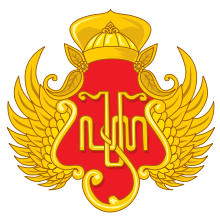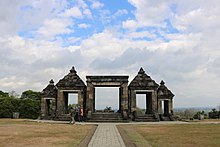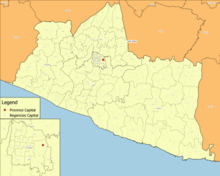Yogyakarta Special Region
Co-ruled by the Yogyakarta Sultanate and the Duchy of Pakualaman, the region is the only officially recognized diarchy within the government of Indonesia. The city of Yogyakarta is a popular tourist destination and cultural center of the region. The Yogyakarta Sultanate was established in 1755 and provided unwavering support for Indonesia's independence during the Indonesian National Revolution (1945–1949). As a first-level division in Indonesia, Yogyakarta is governed by Sultan Hamengkubuwono X as the governor and Duke Paku Alam X as the vice governor. With a land area of just 3,170.65 km, it is the second-smallest province-level entity of Indonesia after Jakarta.
History

In Javanese, it is pronounced [joɡjaˈkartɔ], and named after the city of Ayodhya in Javanese-Hindu mythology. The Dutch name of the Special Region is Djokjakarta.
The Sultanate has existed in various forms and survived through the rule of the Dutch and the 1942 invasion of the Dutch East Indies by the Japanese Empire. In August 1945 Indonesia's first president, Sukarno proclaimed the independence of the Indonesian Republic, and by September of that year, Sultan Hamengkubuwono IX and Duke Sri Paku Alam VIII had sent letters to Sukarno expressing their support for the newly born nation of Indonesia, in which they acknowledged the Yogyakarta Sultanate as part of the Indonesian Republic. The Sunanate of Surakarta did the same, and both of the Javanese kingdoms were awarded special status as special regions within the Indonesian Republic. However, due to a leftist anti-royalist uprising in Surakarta, the Sunanate of Surakarta lost its special administrative status in 1946 and was absorbed into the province of Central Java.
Yogyakarta's overwhelming support and the Sultan's patriotism were essential in the Indonesian struggle for independence during the Indonesian National Revolution (1945–1949). The city of Yogyakarta became the capital of the Indonesian Republic from January 1946 to December 1948 after the fall of Jakarta to the Dutch. Later, the Dutch also invaded Yogyakarta causing the Indonesian Republic's capital to be transferred again to Bukittinggi in West Sumatra on 19 December 1948. In return for Yogyakarta's support, the declaration of Special Authority over Yogyakarta was granted in full in 1950 and Yogyakarta was given the status of a Special Administrative Region, making Yogyakarta the only region headed by a monarchy in Indonesia.
The Special Region was struck by a 6.3-magnitude earthquake on 27 May 2006, killing 5,782 people, injuring approximately 36,000, and leaving 600,000 people homeless. The region of Bantul suffered the most damage and deaths.
Geography

The Special Region is located near the southern coast of Java, surrounded on three sides by the province of Central Java, and with the Indian Ocean on the south side. The population at the 2010 Census was 3,457,491 people, which then increased to 3,668,719 at the 2020 Census; the official estimate for mid-2023 was 3,736,489 (comprising 1,849,540 males and 1,886,950 females). It has an area of 3,170.65 km, making it the second-smallest area of the provinces in Indonesia, after the Jakarta Capital Region. Along with surrounding areas in Central Java, it has some of the highest population densities of Java.
Mount Merapi is located to the immediate north of the city of Yogyakarta and Sleman Regency. It is the most active volcano in Indonesia and has erupted regularly since 1548. It last erupted in October–November 2010, killing and injuring many people and temporarily displacing approximately 100,000 residents.
Geo-heritage sites


Indonesia has several geo-heritage sites in the Yogyakarta Special Region. It has been declared by the Geological Agency of the Ministry of Energy and Mineral Resources. The sites consist of nine sites: Eocene limestone in Gamping (Sleman Regency), pillow lava in Berbah (Sleman), pre-historic volcanic sediment in Candi Ijo, Prambanan (Sleman), dunes in Parangtritis Beach (Bantul Regency), Kiskendo cave, and former manganese mining site in Kleripan (Kulonprogo regency), the prehistoric volcano in Nglanggeran (Gunungkidul regency), Wediombo-Siung beaches (Gunungkidul) and Bioturbasi site in Kalingalang (Gunungkidul). The most unusual one is pillow lava in Berbah (Sleman) which is a big, rough black rock that lies on the bank of the narrow Dengkeng River. The prehistoric volcano in Nglanggeran (Gunungkidul Regency) has already been developed as a tourist destination.
Government and politics
Governor and legislature
According to Act No. 22 of 1948 (which is also the basis of Act No. 3 of 1950 on the formation of DIY), the Head and Vice Head of the Special Region are appointed by the president from the descendants of the ruling family in the region before Indonesian independence with the conditions of "skill, honesty, and loyalty, and keeping in mind the customs of the area." Thus, the Head of the Special Region, until 1988, was automatically held by the reigning Sultan of Yogyakarta, and the Vice Head of the Special Region, until 1998, was automatically held by Prince Paku Alam who was on the throne. The nomenclature of the Governor and Vice Governor of the Special Region has only been used since 1999 with the issuance of Act No. 22 of 1999. Since 2012, the mechanism for filling the positions of Governor and Vice Governor of DIY is regulated by Act No. 13 of 2012 on the Uniqueness of the Special Region of Yogyakarta.
The province has a regional legislature, the Special Region of Yogyakarta Regional House of Representatives, which as of the 2024 election has 55 members. The largest party in the legislature is the Indonesian Democratic Party of Struggle.
Administrative divisions
The Special Region of Yogyakarta (provincial level) is subdivided into four regencies (kabupaten) and one city (kota), and divided further into districts (kapanewon or kemantren in the city of Yogyakarta) and villages (rural kalurahan or urban kelurahan, doublet); these are listed below, with their areas and their population at the 2000, 2010 and 2020 Censuses, with their present estimates, as of mid-2023.
| Kode Wilayah |
Name | Capital | Area (km) | Population 2000 Census |
Population 2010 Census |
Population 2020 Census |
Population mid 2023 Estimate |
HDI 2021 Estimates |
|---|---|---|---|---|---|---|---|---|
| 34.01 | Kulon Progo Regency | Wates | 577.22 | 371,000 | 388,859 | 436,395 | 443,053 | 0.747 (High) |
| 34.02 | Bantul Regency | Bantul | 511.71 | 781,000 | 911,503 | 985,770 | 1,009,434 | 0.802 (Very High) |
| 34.03 | Gunungkidul Regency | Wonosari | 1,475.15 | 670,400 | 675,382 | 747,161 | 751,011 | 0.701 (High) |
| 34.04 | Sleman Regency | Sleman | 573.75 | 901,400 | 1,093,110 | 1,125,804 | 1,157,292 | 0.840 (Very High) |
| 34.71 | Yogyakarta City | Yogyakarta City | 32.82 | 396,700 | 388,627 | 373,589 | 375,699 | 0.871 (Very High) |
| Totals | 3,170.65 | 3,121,045 | 3,457,491 | 3,668,719 | 3,736,489 | 0.802 (Very High) |

Located within the Special Region of Yogyakarta, the city of Yogyakarta is known as a center of classical Javanese fine art and culture, such as batik, ballet, drama, music, poetry, and shadow puppetry. It is also one of Indonesia's most renowned centres of higher education. At the city's core is the Sultan's palace, the Kraton. While the city sprawls outward in all directions from the Kraton, the "modern" centre of the city is located to the north.
The Special Region forms one of Indonesia's 84 national electoral districts to elect members to the People's Representative Council. The Yogyakarta S.R. Electoral District consists of all of the 4 regencies in the province, together with the city of Yogyakarta, and elects 8 members to the People's Representative Council.
Demographics
| Year | Pop. | ±% |
|---|---|---|
| 1971 | 2,489,360 | — |
| 1980 | 2,750,813 | +10.5% |
| 1990 | 2,913,054 | +5.9% |
| 1995 | 2,916,779 | +0.1% |
| 2000 | 3,122,268 | +7.0% |
| 2010 | 3,457,491 | +10.7% |
| 2020 | 3,668,719 | +6.1% |
| 2023 | 3,736,489 | +1.8% |
| Source: Badan Pusat Statistik (BPS), 2024 and previous | ||
Language
Aside from the Indonesian language, the Javanese language is also designated as the official language of the Special Region of Yogyakarta under Yogyakarta Special Region Regulation Number 2 of 2021.
Religion
The majority of the population is Muslim, which is 92.94%, the rest are Catholic Christians 4.45%, then Protestant Christians 2.42%, Buddhists 0.08%, Hindus 0.09%, Confucianism and others 0.02%.
Infrastructure
Transport

Yogyakarta is served by Adisutjipto International Airport and Yogyakarta International Airport, the latter being opened for minimum operations in late April 2019 and fully operational starting late March 2020. There are two main railway stations: Lempuyangan Station and Yogyakarta railway station.
Yogyakarta is considered one of the major hubs that link the west–east main railway route in Java island. Yogyakarta Station is the main train station located in the center, and Lempuyangan Station is the second train station in the city. The two stations have their schedule to and from other cities on Java island. The Prambanan Express commuter rail service operates west of Yogyakarta Station across Kulonprogo Regency to Purworejo, and KAI Commuter Yogyakarta Line electric commuter rail system operates from east of the station to Surakarta. To the south, in the Bantul region, is the Giwangan bus station, one of the largest bus stations in Indonesia. The Yogyakarta metropolitan centre is surrounded by a ring road.
In 2008, the government of the Special Region of Yogyakarta launched a bus rapid transit system, the Trans Jogja, which connects places in and around Yogyakarta City, including the airport and the Prambanan temple. Today, Trans Jogja has reached other points in the south side of the city.
Education

Yogyakarta is home to more than 100 institutions of higher education in Indonesia, the highest number of higher education institutions of any province in Indonesia. Hence, Yogyakarta earned its nickname "Kota Pelajar" (The City of Students).
Yogyakarta is the home of the first established state university in Indonesia, the Gadjah Mada University.
The Special Region is also the home of the first established private university in Indonesia, the Islamic University of Indonesia, which was founded in 1945. The Indonesia Institute of Arts, the first-established university in fine arts, is also in the region. Other large universities include Yogyakarta State University, Sunan Kalijaga State Islamic University, Sanata Dharma University, Muhammadiyah University of Yogyakarta, and the University of Atma Jaya Yogyakarta.
Sister relationships
Yogyakarta Special Region has signed a sister province relationship or friendly ties agreement with the region/state:
 Kyoto Prefecture, Japan
Kyoto Prefecture, Japan State of California, United States
State of California, United States Gyeongsangbuk-do, South Korea
Gyeongsangbuk-do, South Korea Tyrol, Austria
Tyrol, Austria Chiang Mai Province, Thailand
Chiang Mai Province, Thailand
See also
Notes
- ^ Badan Pusat Statistik, Jakarta, 28 February 2024, Provinsi Daerah Istimewa Yogyakarta Dalam Angka 2024 (Katalog-BPS 1102001.34)
- ^ Indonesia's Population: Ethnicity and Religion in a Changing Political Landscape. Institute of Southeast Asian Studies. 2003.
- ^ Kementerian Agama Republik Indonesia Wilayah DIY (15 March 2010). "Kementerian Agama RI | Kantor Wilayah DI Yogyakarta". Yogyakarta.kemenag.go.id. Archived from the original on 21 July 2011. Retrieved 7 February 2011.
- ^ Badan Pusat Statistik (2023). "Produk Domestik Regional Bruto (Milyar Rupiah), 2022" (in Indonesian). Jakarta: Badan Pusat Statistik.
- ^ Badan Pusat Statistik (2023). "Produk Domestik Regional Bruto Per Kapita (Ribu Rupiah), 2022" (in Indonesian). Jakarta: Badan Pusat Statistik.
- ^ Badan Pembangunan Nasional (2023). "Capaian Indikator Utama Pembangunan" (in Indonesian). Jakarta: Badan Pembangunan Nasional.
- ^ "Indeks Pembangunan Manusia 2024" (in Indonesian). Statistics Indonesia. 2024. Retrieved 15 November 2024.
- ^ Album seni budaya Daerah Istimewa Yogyakarta = cultural album of the special territory of Yogyakarta, Proyek Media Kebudayaan, Departemen Pendidikan dan Kebudayaan = Project of Cultural Media, Ministry of Education and Culture, 1982/1983, 1982, retrieved 12 April 2022
- ^ Yogyakarta (Indonesia : Daerah Istimewa). Jawatan Penerangan (1974), A short guide to Jogjakarta, Inter Documentation Company, retrieved 12 April 2022
- ^ "Definition of YOGYAKARTA". www.merriam-webster.com. Retrieved 16 November 2022.
- ^ "Nomenklatur Daerah Istimewa Yogyakarta dan Penggunaannya" (PDF).
- ^ "Luas wilayah". jogjaprov.go.id. 1 June 2010.
- ^ "Raffles and the British Invasion of Java," Tim Hannigan, Monsoon Books, 2012, ISBN 9789814358866, .. Its full formal name was Ngayogyakarta Hadiningrat. Like the Thai town of Ayutthaya, Yogyakarta was named for Ayodhya, the mythical birthplace of the Hindu god Rama ..
- ^ "Indonesia lowers quake death toll". CNN. 6 June 2006. Archived from the original on 15 June 2006. Retrieved 6 June 2006.
- ^ Biro Pusat Statistik, Jakarta, 2011.
- ^ Badan Pusat Statistik, Jakarta, 2021.
- ^ "Update: Indonesia Volcano Death Toll Soars Past 100; 'Many Children Dead, by Gandang Sajarw". Jakarta Globe. 5 November 2010. Archived from the original on 17 September 2012. Retrieved 5 November 2010.
- ^ "Pictures: Indonesia's Mount Merapi Volcano Erupts". News.nationalgeographic.com. 26 October 2010. Archived from the original on 29 October 2010. Retrieved 7 February 2011.
- ^ Undang-undang Nomor 13 Tahun 2012 tentang Keistimewaan Daerah Istimewa Yogyakarta (Act 13) (in Indonesian). People's Representative Council. 2012.
- ^ "Terpilih 55 Caleg untuk DPRD DIY hasil Pemilu 2024". Pikiran Rakyat. 8 March 2024. Retrieved 24 March 2024.
- ^ "Human Development Indices by Province, 2020-2021 (New Method)" (in Indonesian). Retrieved 3 July 2022.
- ^ Law No. 7/2017 (UU No. 7 Tahun 2017) as amended by Government Regulation in Lieu of Law No. 1/2022 and Regulation of General Elections Commission No. 6/2023.
- ^ Peraturan Daerah Daerah Istimewa Yogyakarta Nomor 2 Tahun 2021 tentang Pemeliharaan dan Pengembangan Bahasa, Sastra, dan Aksara Jawa (Regional Regulation 2) (in Indonesian). Governor of Special Region of Yogyakarta. 2021.
- ^ "Jumlah Penduduk Menurut Agama" (in Indonesian). Ministry of Religious Affairs. 31 August 2022. Retrieved 29 October 2023.
- ^ "Trans Jogja Busway: Yogyakarta, Central Java". Indonesialogue.com. 26 February 2008. Archived from the original on 10 March 2012. Retrieved 7 February 2011.
- ^ "List of private higher education institutions in the Province of Yogyakarta". Kopertis4.or.id. Archived from the original on 26 August 2004. Retrieved 7 February 2011.
- ^ "Kyoto prefecture List of Friendly and Sister City". pref.kyoto.jp. Retrieved 7 February 2011.
- ^ "California's Sister-State Relationship with Special Province of Yogyakarta, Indonesia". senate.ca.gov. Retrieved 6 January 2020.
- ^ "Gyeongsangbuk-do Province Website".
- ^ Biro Kerjasama (2006). Bunga Rampai Kerjasama Luar Negeri Propinsi DIY. Yogyakarta: Pemerintah Propinsi DIY.
- ^ สภาพทั่วไปของจังหวัดเชียงใหม [General condition of Chiang Mai Province] (PDF) (in Thai). Archived from the original (PDF) on 16 August 2016. Retrieved 23 June 2016.
- ^ Concurrently as Yogyakarta Sultanate.
- ^ Concurrently as Duke of Pakualam.
- ^ also known as Special Territory of Yogyakarta
English: /ˌjoʊɡjəˈkɑːrtə/; Indonesian: Daerah Istimewa Yogyakarta, Javanese: ꦥꦤꦒꦫꦩꦶꦫꦸꦁꦒꦤ꧀ꦔꦪꦺꦴꦒꦾꦏꦂꦠ, romanized: Panagara Mirunggan Ngayogyakarta
References
- Regional Office of the Department of Tourism, Post and Telecommunication for the Special Region of Yogyakarta. (1997) Guide To Yogyakarta. Yogyakarta: Department of Tourism, Post and Telecommunication.
- Ricklefs, M.C. (2001) A history of modern Indonesia since c.1200 (3rd ed.). Stanford: Stanford University Press. pp. 126–139, 269–271. ISBN 0-8047-4480-7
- Ricklefs, M.C. (1974) Jogjakarta under Sultan Mangkubumi, 1749–1792: A history of the division of Java. London Oriental Series, vol. 30. London: Oxford University Press, (Revised Indonesian edition 2002)
- Soemanto, Bakdi (1992) Cerita Rakyat dari Yogyakarta Jakarta: Grasindo (In Indonesian)
- Soemardjan, S. (1962) Social Changes in Yogyakarta, Ithaca, N.Y. Cornell University Press.
External links
 Yogyakarta travel guide from Wikivoyage
Yogyakarta travel guide from Wikivoyage- Sochaczewski, Paul Spencer (14 June 1994). "A True Javanese Fairy Tale: The Sultan and the Mermaid". The New York Times. Retrieved 7 February 2011.

